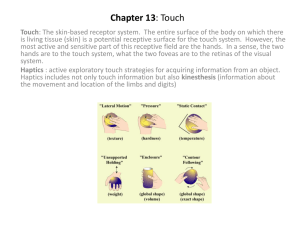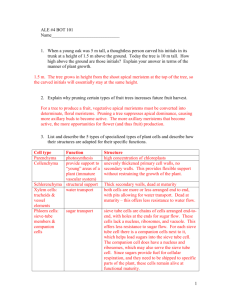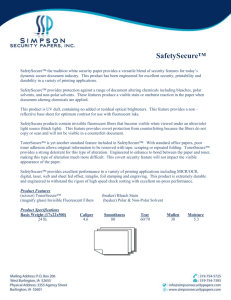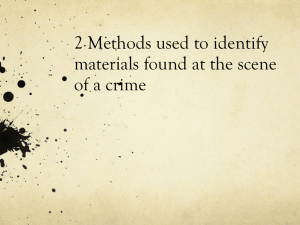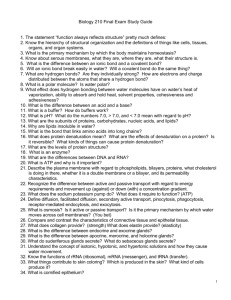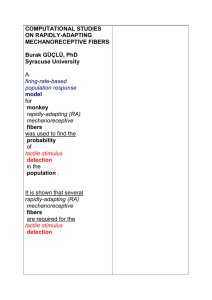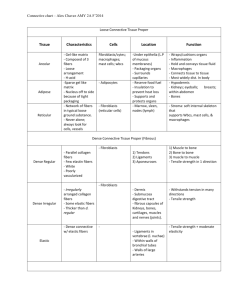Fibers in rose quartz: HRTEM & AEM investigations
advertisement
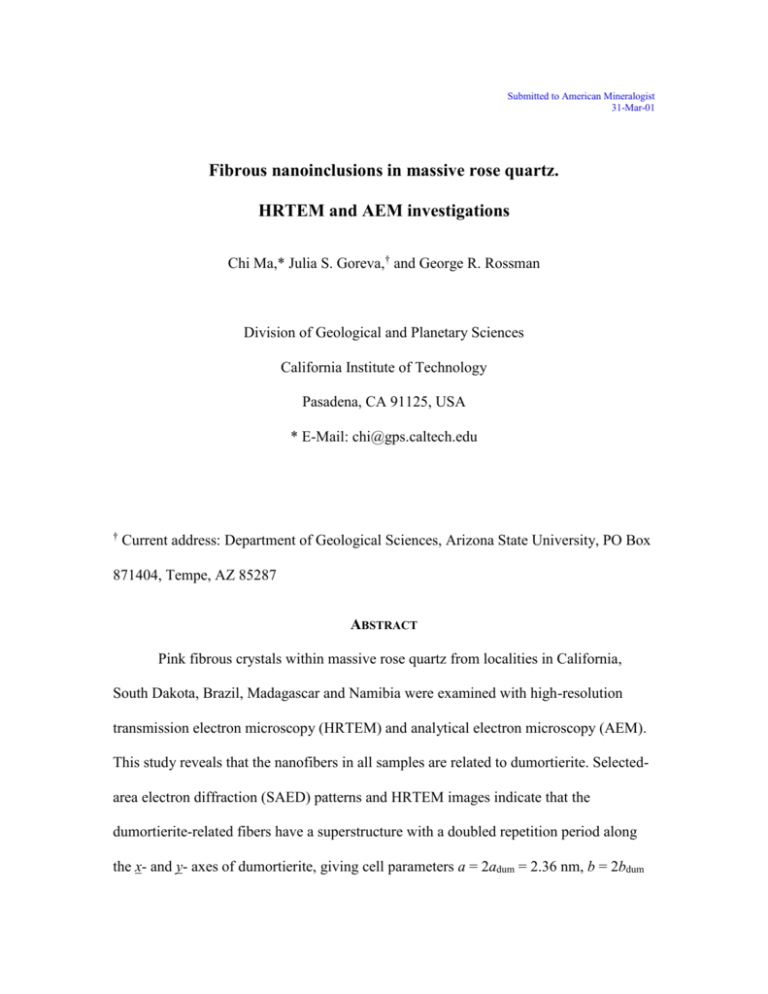
Submitted to American Mineralogist 31-Mar-01 Fibrous nanoinclusions in massive rose quartz. HRTEM and AEM investigations Chi Ma,* Julia S. Goreva,† and George R. Rossman Division of Geological and Planetary Sciences California Institute of Technology Pasadena, CA 91125, USA * E-Mail: chi@gps.caltech.edu † Current address: Department of Geological Sciences, Arizona State University, PO Box 871404, Tempe, AZ 85287 ABSTRACT Pink fibrous crystals within massive rose quartz from localities in California, South Dakota, Brazil, Madagascar and Namibia were examined with high-resolution transmission electron microscopy (HRTEM) and analytical electron microscopy (AEM). This study reveals that the nanofibers in all samples are related to dumortierite. Selectedarea electron diffraction (SAED) patterns and HRTEM images indicate that the dumortierite-related fibers have a superstructure with a doubled repetition period along the x- and y- axes of dumortierite, giving cell parameters a = 2adum = 2.36 nm, b = 2bdum = 4.05 nm, c = cdum = 0.47 nm. Computer simulations suggest that periodic arrangements of two different M(1) site occupations in the octahedral face-sharing chains give rise to the superstructure. One type of M(1) site is occupied mainly by Al, whereas the other type is dominated by Ti and Fe. Simulated structural images based on our proposed model match the experimental structural images. Most of the fibers, elongated along the z axis, are free of defects. AEM analysis shows that the dumortierite-related fibers have a composition similar to well characterized dumortierite, but that they contain a greater amount of Fe substituting for Al in the M(1) sites. B was detected in all fibers examined by electron energy loss spectroscopy as well as in sillimanite crystals found as a minor component in one rose quartz from Brazil. Key Words: Fibers, rose quartz, borosilicate, dumortierite, superstructure, sillimanite, HRTEM, AEM, SAED, Image simulation. 2 INTRODUCTION Fine fibers in massive rose quartz have been observed and, since the 1930’s, were generally presumed to be rutile (reviewed by Rossman, 1994, and Goreva et al., 2001). Applin and Hicks (1987) concluded that the fiber phase in rose quartz from a Montana locality is dumortierite based on their TEM and powder XRD analyses. However, their fibers’ XRD peaks are not well matched with dumortierite’s peaks in many details. Our XRD on bulk fibers from rose quartz from a variety of localities also show similar results (Goreva et al., 2001). Significant differences observed in the IR and Raman spectra of these fibers, however, cast doubt on their identification as dumortierite. These differences were the motivation for a more detailed TEM study of the fibers. Most fibers in massive rose quartz are less than 1 m in thickness and ideal for TEM examinations (Fig. 1). Previously the only published TEM results on those fibers were those of Applin and Hicks who showed that the c-axis repeat of the fibers from the Montana locality was appropriate for dumortierite. TEM study of dumortierite has been very limited as well. Only van Dyck et al. (1976) carried out HRTEM on dumortierite from Nevada along the [001] zone. We present here a detailed analysis of the structural nature of individual fibers based on HRTEM and AEM studies. EXPERIMENTAL PROECDURES Samples Rose quartz samples were selected from Madagascar (GRR1815), Olivera dos Brejinhos in western Bahia, Brazil (GRR1819), Joai’ma, Minas Gerais, Brazil (GRR1864), Rossing (not stated in the original sample description as received, but 3 inferred from the sample), Namibia (GRR1818), Scott Mine, Custer, South Dakota (GRR1820), and Schindler Mine, Riverside County, California (GRR1996). All rose quartz samples are from pegmatite deposits. Under routine examination at 400x with an optical microscope, mineral inclusions were observed in only two of the samples selected for this study. In these two samples numerous (GRR1864) and occasional (GRR1819) needle-like crystals up to 10 m in thickness are present. Fibers were extracted from crushed quartz by dissolution in HF and then were concentrated and purified. More information on these specimens and fiber purification procedure is given in Goreva et al. (2001). For comparison, detailed, parallel studies were conducted on a well-characterized blue dumortierite standard from Saharina, Madagascar (GRR347), studied by Moore and Araki (1978). Electron diffraction patterns were also obtained from pink dumortierite from Dehesa, San Diego County, California (GRR122), and blue dumortierite from the Cargo Muchacho Mountains, Imperial County, California (CIT14110). Transmission electron microscopy A JEOL Atomic Resolution Microscope (ARM) operated at 800 kV and an In-situ JEOL 200CX TEM in the National Center for Electron Microscopy (NCEM), Lawrence Berkeley Laboratory (LBL), a Philips EM430 STEM operated at 300 kV at Caltech and an ISI TEM operated at 200 kV at the Jet Propulsion Laboratory were used for HRTEM imaging and/or electron diffraction analysis. AEM analysis was performed with a JEOL 200CX at the NCEM, LBL. The JEOL 200CX is equipped with a high angle energy dispersive X-ray spectrometer (EDS) and a Gatan 666 electron energy loss spectrometer with parallel detection (PEELS) capable of routinely achieving 1.5eV resolution. The k 4 factors for the fiber quantitative EDS analysis were obtained using dumortierite, sillimanite, titanite and andradite as standards under the same analytical conditions. TEM specimens of the fibers were prepared in two ways: (1) crushed fiber particles dispersed on a carbon film supported by a copper grid so the elongation of fibers is almost parallel to the film, (2) sectioning with a diamond microtome to produce thin sections of the fiber normal to the electron beam. The dumortierite standard was prepared by dispersing crushed crystals on a carbon film. Nearly 1000 photos were recorded during this study, allowing confidence that the observations are representative. HRTEM simulations Computer simulations of HRTEM images and electron diffraction patterns were preformed using the NCEMSS (version 1.6) software package provided by Dr. Roar Kilaas. The calculations were carried out with a Sun workstation. The input structure parameters for dumortierite (Pmcn, a = 1.1828 nm, b = 2.0243 nm, c = 0.47001 nm) and sillimanite (Pbnm, a = 0.7479 nm, b = 0.7670 nm, c = 0.5769 nm) were based on Moore and Araki (1978) and Peterson and McMullan (1986), respectively. Two-dimensional structural images were simulated with the multislice approach for a typical range of microscope defocus values, crystal thicknesses, and crystal orientations, using a set of optical constants appropriate for the ARM, Philips EM430 and JEOL 200CX microscopes. The simulated and experimental images are compared visually for interpretation. Figure 2 illustrates computed HRTEM images of the dumortierite structure at different orientation, thickness and defocus conditions. The simulations show that image details are highly sensitive to defocus, orientation and the calculated range of 5 specimen thickness. Hundreds of simulated images were generated in this study to assist in interpreting experimental atomic images. Infrared Spectroscopy Infrared spectra were obtained using an Nicolet 860 Magna spectrometer and a SpectraTech Continuum IR microscope. Sample preparation and operating conditions were comparable to those reported in Goreva et al. (2001). RESULTS Electron diffraction Selected-area electron diffraction (SAED) patterns of the zone-axes were obtained from a number of single fiber crystals. Figure 3 shows representative zone-axis SAED patterns of single fibers from rose quartz, comparing with same zone-axis patterns of the dumortierite standard. These SAED patterns from the fibers, obtained from different orientations, are assigned to [100], [010], [110], [111] and [001] zone-axis electron diffraction patterns based on a dumortierite structural model. The [010], [110] and [111] patterns were observed from same area of single fibers through tilting. The [100] zoneaxis pattern is almost identical to the dumortierite pattern. However, the [110] and [111] zone-axis patterns of the fibers show weak but relatively sharp reflections along the [1-10]* direction at ½(1-10)dum*. This indicates that the fiber has a periodicity along [1-10]* = 2d(1-10)dum, which implies a superstructure of dumortierite with a doubled repetition period along both the x- and the y-axes (i.e., asuper = 2adum = 2.38 nm; bsuper = 2bdum = 4.05 nm). The [110] zone-axis pattern of a fiber can be easily mistaken for a [100]-zone pattern (Fig. 3A). However, the intensity distributions of the reflections are 6 different. This superstructure was observed in the electron diffraction pattern of fibers from all localities examined. It was not observed in any of the electron diffraction patterns of the dumortierite samples. Figure 4A contains a series of computed electron diffraction patterns from a welloriented dumortierite crystal with uniform 10 nm thickness. The almost identical [100] zone-axis patterns from a fiber and from the dumortierite standard (Fig. 3) are not well matched with the simulated [100]-zone pattern of dumortierite (Fig. 4A) since dynamic diffraction causes the presence of forbidden reflections such as (001) and (0k0) where k = 2n+1 in the experimental SAED patterns. The [001] zone-axis SAED patterns of the fibers and dumortierite are also similar and are matched closely with the simulated pattern of dumortierite (Fig. 3 & 4A) and the experimental SAED pattern of dumortierite from the Rochester mining district, Nevada (van Dyck et al. 1976). SAED patterns show that nearly all fibers in rose quartz have a superstructure of the dumortierite structure, and are elongated along the z axis. Few [11l]-zone singlecrystal SAED patterns indicate that a very small number of fibers might have the dumortierite structure because there are no weak reflections along the [110]* direction at ½(110)*. Such patterns, however, might be from a thin domain where the superstructure information has weakened and/or has been damaged by the electron beam. The zone-axis SAED patterns of reference dumortierite (GRR347) examined in this study reveal that the dumortierite crystal has the ideal structure proposed by Moore and Araki (1978) (e.g., Fig. 3B and 4A). These patterns are consistent with the simulated dumortierite electron diffraction patterns. 7 Most SAED patterns of single fiber crystals are clear without diffusive streaking. This indicates that most fiber crystals have an ordered structure. Only a few electron diffraction patterns revealing the superstructure show weak streaking (e.g., Fig. 3A) along [1-10]*. The HRTEM images show that the streaking was not derived from stacking faults but more likely was from uneven cation occupations in the M(1). Convergent-beam electron diffraction patterns were also obtained from some dumortierite-related fibers. Figure 5 illustrates a [010]-zone whole pattern of a fiber showing a weak First-Order Laue Zone (FOLZ) and a sharp Second-Order Laue Zone (SOLZ). The FOLZ reveals that the repeat along [010] is 4.05 nm (i.e., the periodicity of the fiber along the y axis = 2bdum). HRTEM imaging Bright-field images at low-magnification reveal the fibers' morphology (Fig. 1). In general, the fibers vary in thickness mainly from 100 nm to 800 nm but can be up to 1200 nm. Two-dimensional structural images from a number of single fibers were obtained along with their zone-axis SAED patterns. HRTEM images indicate that the fibers are almost free of stacking faults, deformation and dislocations. HRTEM images (Fig. 6) of single fibers corresponding to the orientation of the [110] and [111]-zone SAED patterns (Fig. 3A) show that the true periodicity along the [110] direction is 2.04 nm and the subperiodicity of 1.02 nm appears in the thin area. Figure 7 illustrates the [100] zone-axis images showing sub-periodicity of 2.02 nm along [010]. Cross-sections of the fibers (Fig. 8) reveal (010), (100), (110) 8 and (140) surface planes indexed according to the dumortierite superstructure. A single (110) twin was observed in only one fiber. The irregular-shape of the surface layer (< 2 nm thick) of the fibers in Figure 6B is likely caused by electron beam damage. In general, electron beam damage on the fiber phase is not serious although the knock-on damage plays a role in degrading its structural ordering. Chemical Composition AEM analysis on individual fibers shows that in all samples the fibers from rose quartz are aluminum-borosilicates, having a chemical composition similar to dumortierite. Mean structural formulae of the fibers are given in Table 1. EDS analysis reveals that the fibers contain a small amount of Ti and Fe substituting for Al. The Fe content varies slightly. The contents of Ti and Fe are slightly higher than in blue dumortierite (Fig. 9), but overlap the range of these elements in pink dumortierite (Alexander et al. 1986). In the fibers from rose quartz, Ti content is generally greater than Fe content. Ti and Fe are believed to occupy the M(1) sites in dumortierite (Platonov et al. 2000). The composition of the fibers is plotted together with the compositions of dumortierites in Figure 9. Borate Content. FTIR analyses on bulk, extracted fibers, including those used in this study, reveal that borate is present in about the same B to Si ratio as in dumortierite (Goreva et al. 2001). PEELS analysis reveals that B is present in each single fiber from rose quartz (Fig. 10A). Although attempts to obtain reproducible quantitative PEELS analyses were, in part, frustrated by the irregular shape and thickness of the individual 9 samples, these analyses also show that the B content of the fibers is comparable to that of dumortierite (Fig.10B). Hydroxide-Fluoride Content. Electron microprobe analyses failed to find F in either the bulk fibers (GRR 1815) or dumortierite (GRR 347). Our FTIR analyses show that OH is present in the fibers and suggest that it is present at somewhat greater concentrations than observed in dumortierite. Figure 11 is a representative comparison of the OH absorption pattern of an unpolarized spectrum of a polycrystalline slab (c, c orientation) of pink (Dehesa) dumortierite and a mat of pink fibers. Both samples show an additional but variable hydrous component at about 3240 cm-1 that we associate with contamination in the bulk samples. Spectroscopic differences between dumortierite and the fibers are apparent in the borate bands in the 2000 and 3200 cm-1 region. They are expected based on previously identified spectroscopic differences in the 450-2000 cm-1 range (Goreva et al, 2001). Because of scattering from the bulk mats of fibers, the spectra of the mats have strongly sloping backgrounds. The spectrum of the fibers in Figure 11 was subjected to an arbitrary correction so that the samples have about the same slope between 4000 and 2000 cm-1. In addition, because the effective spectroscopic thickness of the fiber mat could not be determined accurately, the spectra were scaled to have the same intensity at 2850 cm-1. These arbitrary corrections render it impossible to establish the absolute concentration of OH in the fibers. Other Mineral Fibers In several recent books and articles, rutile fibers (TiO2) are still considered to be the cause of color in rose quartz. A control experiment with light yellow rutilated quartz (CIT 5585, Minas Gerais, Brazil) demonstrated that fine rutile needles (1.5 m wide - 10 identity verified by Raman spectroscopy) survive our acid dissolution process intact. Thus, if rutile fibers were present in rose quartz in significant numbers, we should detect them. However, rutile fibers were not found in any of our rose quartz samples. Along with the dumortierite-related fibers, a significant proportion of acicular sillimanite nanocrystals (~ 10%) were admixed with the fibers extracted from one sample of Brazilian rose quartz (GRR1864). Figure 12 illustrates a HRTEM image of a sillimanite crystal with its [110] zone-axis SAED pattern, which is closely matched to the calculated image and electron diffraction pattern. The composition of the sillimanite crystals is almost identical to Al2SiO5 (Table 1). PEELS analysis shows that boron occurs in the sillimanite (Fig. 10C). The B content appears not to be caused by contamination of dumortierite-related fibers, or inclusions in sillimanite of borosilicates with BO3 groups. This is consistent with a prior observation of boron in macroscopic sillimanite (Grew and Rossman 1985). Similar, but larger (up to 15 m wide) acicular Al2SiO5 crystals were observed as a minor component in the SEM images of fibers extracted from samples GRR1819 and GRR1820 of Goreva et al. (2001) and were presumed to also be sillimanite. Although the PEELS spectra were obtained under different conditions (e.g., crystal thickness, orientation), the intensity of the boron peak in the PEELS spectrum is visually as great for sillimanite as it is for dumortierite. Boron is a stoichiometric component of dumortierite, whereas boron has only been reported as a minor component of sillimanite (Grew and Rossman 1985). While this might imply that the boron content in sillimanite from rose quartz is high, the chemical analysis of Table 2 does not indicate a significant deviation from stoichiometry. 11 DISCUSSION Experimental TEM results in this study indicate most fibers from rose quartz are a superstructure of dumortierite with a doubled repetition period along both the x and the y axes. The superstructure can be modeled based on a periodic variation of the M(1) position in the dumortierite structure. The ideal dumortierite structure consists of three chain types (each built of AlO6 octahedra) which run parallel to the z axis: face-sharing chain, 1 [M(4)4O12] double chains, and 1 1 [M(1)O3] [M(2)2M(3)2O12] chains (Moore and Araki 1978). The M(2), M(3) and M(4) sites are occupied totally by Al. The M(1) site is occupied mainly by Al and cation vacancies in a 3:1 ratio in normal dumortierite (Moore and Araki 1978), and by Mg in magnesiodumortierite (Chopin et al. 1995). The AEM analyses of individual fibers show the presence of Ti and Fe (Table 1). These two cations are assigned to the M(1) site in dumortierite (Alexander et al. 1986). We suggest that there are two types of cation occupations in the M(1) site; they are Type I: Al, Type II: Ti + Fe. On this crystal-chemical basis, a model for the superstructure is constructed, as illustrated in Figure 13. In this model, viewed down the [001] direction, the Type II site is surrounded by Type I sites along the [100], [110] and [010] directions of the dumortierite structure. The superstructure derives from the regular distribution of these two types of cation occupations in the M(1) site. In the superstructure unit, three quarters of the M(1) sites are Type I (Al) and one quarter are Type II (Ti and Fe). The stoichiometry of this model, [Al6(Al0.75)I(Ti,Fe)II0.25]Si3BO18, comes close to predicting the experimentally determined composition of the fibers in Table 1. The model does not exclude minor 12 amounts of Ti and Fe in the Type I Al position nor does it exclude cation vacancies in either the Type I or Type II cation sites. The simulated electron diffraction patterns of this model (Pmcn, a = 2.3656 nm, b = 4.0486 nm, c = 0.47001 nm) (Fig. 4B) match well with the experimental SAED patterns of the dumortierite-related fibers (Fig. 3A). The simulated HRTEM images also closely match the experimental images of the fibers (Fig. 14). These simulations indicate that the superstructure occurring in the fibers indeed has such a cation configuration. The streaking along the [110] direction in some SAED patterns of single fibers might correspond to some cation disordering in the M(1) sites. The chemistry of the fibers (Table 1) shows an average Al 0.66 Ti 0.18 Fe 0.13 per formula in the M(1) site, which suggests that about 20% of the Ti and Fe are located in the Type I position with Al. It is likely that uneven distribution of those Ti and Fe in the Type I position give rise to the streaking along [1-10]* on some of the fibers’ SAED patterns. It is apparent that Ti and Fe in the Type II position of the M(1) site are disordered along the z axis, whereas Al in the Type I position is ordered in the M(1) site or partly disordered when minor Ti, Fe or vacancies are present in the Type I position along with Al. This model predicts that in the fibers c = cdum = 0.47 nm without a doubled or tripled repetition, as is observed in the experimental electron diffraction results. If Al, Ti and Fe are randomly distributed in the M(1) site along z*, the dumortierite structure occurs. This might be the case for a few fibers whose [11l] SAED patterns are almost identical to these of ideal dumortierite crystals. Our model indicates that the pink color of the fibers results from intervalence charge transfer between Fe2+ and Ti4+ in the M(1) site. A similar mechanism has 13 previously been proposed as the cause of color of dumortierite (Alexander et al., 1986; Platonov et al., 2000). Although the fibrous borosilicate phases observed by HRTEM may seem volumetrically insignificant in rose quartz (Goreva et al. 2001), they are crucial to the very definition of rose quartz. If the dumortierite-related fibers are cogenetic with sillimanite, then constraints could be placed on the temperature of formation of both rose quartz and the fibers. While it is possible that the fine acicular sillimanite crystals extracted from GRR1864 are cogenetic with the dumortierite-like fibers, it is likely, that the rose fibers form from exsolution, post crystallization, under conditions unrelated to the formation of the larger sillimanite crystals microscopically observed in GRR1864, and in samples GRR1819 and GRR1820 of Goreva et al. (2001). These more likely were incorporated through crystal capture during the growth of the quartz. Ironically, these microscopically visible needles that captured the attention of many researchers appear to have no relationship to the origin of color of rose quartz. These observations raise the question of whether the ordering we observe in the fibers is a result of growth at a lower temperature than usual for dumortierite. It is reasonable to expect that exsolved phases might display higher ordering than their directly crystallized counterparts because lower temperature formation generally leads to higher order. In our case, exsolution presumably occurred at a temperature below 400°C. In this respect, it would be interesting to find a locality with multiple generations of dumortierite formed at different temperatures and examine the state of ordering in the mineral. 14 CONCLUSIONS Borosilicate fibers exist in massive rose quartz from vein deposits and pegmatites worldwide and they are the cause of the pink color of rose quartz (Goreva et al. 2001). These sub-micrometer wide, pink fibers are related to dumortierite. Nearly all of them have a previously uncharacterized superstructure of dumortierite with a doubled repetition period along both the x and the y axes. Computer simulations show that the superstructure is due to an ordered arrangement of two types of cation occupations on the dumortierite M(1) site. We propose that the color of the fibers is due to Fe2+ - Ti4+ intervalence charge transfer in one of the M(1) sites. ACKNOWLEDGMENTS We thank Ulrich Dahmen and Christian Kisielowski for allowing us to access the ARM and the JEOL 200CX microscopes at the National Center for Electron Microscopy, Lawrence Berkeley National Laboratory, Roar Kilaas for helping with the NCEMSS image simulation program, Chengyu Song for assisting with the ARM operation, and Thomas George for allowing us to use the ISI 200 kV HRTEM at the Jet Propulsion Laboratory. Lothar Jung (Quartz Technology, Inc.) provided samples for this study and several stimulating discussions in the early stages of this project. Rock H. Currier (Jewel Tunnel Imports) and Edward Swobota (Beverly Hills, CA) also provided samples that were critical for this study. Primary funding for this project was provided by the White Rose Foundation with additional funding from the National Science Foundation through grant NSF EAR-9804871. 15 REFERENCES CITED Alexander, V.D., Griffen, D.T., and Martin, T.J. (1986) Crystal chemistry of some Feand Ti-poor dumortierites. American Mineralogist, 71, 786-794. Applin, K.R. and Hicks, B.D. (1987) Fibers of dumortierite in quartz. American Mineralogist, 72, 170-172. Chopin, C., Ferraris, G., Ivaldi, G., Schertl, H.-P., Schreyer, W., Compagnoni, R., Davison, C., and Davis, A.M. (1995) magnesiodumortierite, a new mineral from very-high-pressure rocks (western Alps). II. Crystal chemistry and petrological significance. European Journal of Mineralogy, 7, 525-535. Goreva, J., Ma, C., and Rossman, G.R. (2001) Fibrous nanoinclusions in massive rose quartz. The source of rose coloration. American Mineralogist, 86, 466-472. Grew, E.S. and Rossman, G.R. (1985) Co-ordination of boron in sillimanite. Mineralogical Magazine, 49, 132-135. Moore, P.B. and Araki, T. (1978) Dumortierite, Si3B[Al6.75[]0.25O17.25(OH)0.75]: A detailed structural analysis. Neues Jahrbuch fur Mineralogie Abhandlungen, 132, 231-241. Peterson, R.C. and McMullan, R.K. (1986) Neutron diffraction studies of sillimanite. American Mineralogist, 71, 742-745. Platonov, A.N., Langer, K., Chopin, C., Andrut, M., Taran, M.N. (2000) Fe2+-Ti4+ charge transfer in dumortierite. European Journal of Mineralogy, 12, 521-528. Rossman, G.R. (1994) Colored varieties of the silica minerals. In: Silica Physical Behaviour, Geochemistry and Materials applications. Heaney, P.J., Prewitt, C.T. and Gibbs, G.V. (editors). Reviews in Mineralogy, 29, 433-467. 16 van Dyck, D., Tambuyser, P., van Landuyt, J., and Amelinckx, S. (1976) High-resolution electron microscopy of dumortierite. American Mineralogist, 61, 1016-1019. 17 FIGURE CAPTIONS Figure 1. Low-magnification bright field image showing the dispersed fibers on a carbon film. The fibers are from a rose quartz from Madagascar (GRR1815). Figure 2. Simulated HRTEM images of dumortierite with different orientations and at different thickness and defocus conditions using optical constants for the Philips EM430. (A) [100]-zone, (B) [110]-zone. Figure 3. (A) Representative zone-axis SAED patterns of single fibers obtained from different orientations: [100], [010], [110], [111] and [001]. (B) Zone-axis SAED patterns of the dumortierite standard from [100], [110], [111] and [001]. All indices are based on the dumortierite structure determined by Moore and Araki (1978). Figure 4. (A) Simulated electron diffraction patterns of dumortierite in perfect orientations with uniform 10 nm thickness from [100], [010], [110], [111] and [001]. (B) Simulated electron diffraction patterns of the superstructure model (see Discussion) with uniform 10 nm thickness from [100], [010], [110], [112] and [001]. Figure 5. The [010]-zone whole pattern of a fiber from GRR1819 showing the FirstOrder Laue Zone (FOLZ) and the Second-Order Laue Zone (SOLZ). Figure 6. HRTEM images of single fibers showing 2.04 nm real-periodicity along the [110]* direction and 1.02 nm subperiodicity at a thinner area. (A) The [110]-zone, (B) the [112]-zone. Figure 7. HRTEM images of single fibers down the [100] zone-axis showing only subperiodicity along the [010] direction. That is d(020)super = bdum. Figure 8. [001] zone-axis HRTEM images of a fiber from GRR1815 showing its cross section. 18 Figure 9. Octahedral cation contents in the fibers from rose quartz (this study), classic dumortierite (Alexander et al. 1986) and magnesiodumortierite (Chopin et al. 1995). Figure 10. PEELS spectrum of (A) a dumortierite-related fiber (GRR1819), (B) the dumortierite standard (GRR347), and (C) a sillimanite nanocrystal (GRR1864). The boron K edge is evident in all spectra. Figure 11. Comparison of infrared absorption spectrum taken through a mat of pink fibers (GRR 1815) and a polycrystalline slab of pink dumortierite (GRR122) Figure 12. (A) A thin sillimanite crystal from GRR1864. (B) [110] zone-axis HRTEM image of the sillimanite crystal from GRR1864 and its SAED pattern. Figure 13. The superstructure model (a = 2adum, b = 2bdum, c = cdum). The superstructure is strongly pseudohexagonal, with z the pseudohexad axis. There are two types of M(1) chain: Type I filled with Al and Type II occupied by Ti and Fe. Figure 14. HRTEM images of single fibers viewed down the (A) [112] and (B) [110] directions, matched with the inserted simulated images using the superstructure model. 19 TABLE 1. Mean chemical formula of the fibers in rose quartz and reference dumortierite by AEM (EDS) analysis. =============================================================== Sample No. Locality Dumortierite-related fibers* -------------------- ------------------------------------ ------------------------------------------------------------ GRR1815 Madagascar (Al 6.71 Ti 0.15 Fe 0.13) Si 3.00 B O18 GRR1818 Namibia (Al 6.64 Ti 0.17 Fe 0.15) Si 3.02 B O18 GRR1819 Bahia, Brazil (Al 6.68 Ti 0.17 Fe 0.13) Si 3.01 B O18 GRR1864 Minas Gerais, Brazil (Al 6.58 Ti 0.25 Fe 0.09) Si 3.02 B O18 GRR1996 Schindler Mine, CA (Al 6.68 Ti 0.17 Fe 0.13) Si 3.01 B O18 Reference Dumortierite* GRR347 Saharina, Madagascar (Al 6.86 Ti 0.06 Fe 0.06) Si 3.02 B O18 Sillimanite microcrystals† GRR1864 Minas Gerais, Brazil Al 1.98 Fe 0.02 Si 1.00 O 5 ___________________ * ______ Formulas are normalized to BO18. † Normalized to O5. __________________________________________________________________ 20 TABLE 2. Representative cell parameters ========================================================= dumortierite* fibers (GRR 1815) a0 1.1828 nm 2.36 nm 2.3656 nm b0 2.0243 nm 4.05 nm 4.0486 nm c0 0.47001 nm 0.47 nm 0.47001 nm Cell parameters superstructure model --------------------------------------------------------------------------------------------------------------------- * From Moore and Araki (1978) ---------------------------------------------------------------------------------------------------------------------- 21


